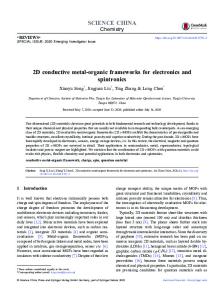Multifunctional Materials: 2D constrained Electronically Conductive Polymer into LDH Matrix
- PDF / 328,338 Bytes
- 6 Pages / 612 x 792 pts (letter) Page_size
- 72 Downloads / 416 Views
Multifunctional Materials: 2D constrained Electronically Conductive Polymer into LDH Matrix El Mostafa Moujahid, Marc Dubois, Jean-Pierre Besse, and Fabrice Leroux* Laboratoire des Matériaux Inorganiques, UMR 6002, Université Blaise Pascal, 63177 Aubière cédex. Email: [email protected] ABSTRACT O-aminobenzenesulfonic acid is incorporated between the sheets of Cu2Cr(OH)6Cl . H2O hydrotalcite-type materials. After heating, a narrow ESR signal characterisitic of conductive polymer behavior is observed for the hybrid phase. The reaction of polymerization fails in absence of the confinement supplied by the LDH host structure and of air atmosphere. The nanocomposite presents an electrochemical behavior in agreement with the presence of large polyanilinesulfonate (PAniS) units, whereas the electropolymerization gives rise first to the formation of dimers. Spin density is found to be greater with the electropolymerization after few cycles than after the heat treatment. INTRODUCTION A great interest has been devoted to the preparation of multifunctional materials based on topotactic reaction with a 2D host structure. For instance, this is illustrated by polyaniline (PANI)/ 2D material system. The polymer is incorporated to enhance the electronic conductivity, the bidimensional framework provides the stability and the processability. PANI was successfully intercalated in several host materials such as V2O5 xerogel [1], MoO3 bronze [2], graphitic oxide [3], α-RuCl3 [4]. This requires generally the use of acidic medium and of an oxidizing agent, except in the case of V2O5 xerogel [1]. In this paper, the incorporation of aniline sulfonic acid (noted as AniS) and its polymerization between Cu2Cr(OH)6Cl . H2O hydrotalcite-type sheets are reported. Hydrotalcite-like LDH materials are described with the ideal formula, [MIIxM1III mII III x (OH)2]intra[A x/m. nH2O]inter , where M and M are metal cations, A the anions and intra and inter denote the intralayer domain and the interlayer space, respectively. The structure consists of brucite-like layers constituted of edge-sharing M(OH)6 octahedra. LDH framework collapses in acidic medium. This explain the difficulty to polymerize PANI whether chemically or electrochemically in presence of LDH host structure. PANI/LDH nanocomposite was first reported by Challier and Slade [5]. Unfortunately, the intercalative polycondensation of aniline in the pre-swollen LDH materials gives rise to ill-defined biphasic samples. Recently, it was shown that the polymerization reaction may even occur in the gallery of LiAl2(OH)6Cl. H2O hydrotalcitetype compound under mild conditions (heat treament at 90°C for 10 days) by using aniline carboxylic acid [6]. At first, we choose Cu2Cr(OH)6Cl . nH2O as host structure, the corrugation of its sheets make it attractive for exchange reaction [7]. In second, AniS is incorporated between the layers with an exchange reaction. The presence of the electrophilic function decreases the potential of monomer, and the polymer form is capable of self-doping [8]
Data Loading...











